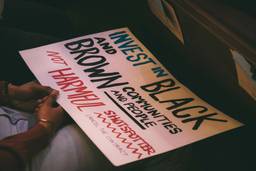This Earth Day, Common Ground Urges us to Rethink Our Relationship With Soil
Regenerative agricultural practices can be transformative, but only if we let them.
Siri Chilukuri

Comment on industrial agriculture mostly appears in the mainstream only when something has gone awry. The current avian flu epidemic comes to mind, but it’s rare for the general public to step back from the alarm of novel threats to take a more comprehensive look at why our current system doesn’t work for its supposed purpose of feeding people.
Common Ground, a new documentary now screening in AMC theaters across the country (and 2023 Tribeca Film Award winner), isn’t afraid to point its finger at Big Ag for the problems with industrial agriculture. It posits that regenerative agriculture is one powerful climate solution that could fix our broken food system. The film positions itself as a sort of an anti-Inconvenient Truth (the famous 2006 climate change documentary from Vice President Al Gore) in the sense that it’s a “good news” documentary about a very bad industry rather than a clarion call for climate action to a disengaged and uninformed public.
In one early scene, Gabe Brown — a regenerative rancher from Bismarck, N.D. — points to an expanse of seemingly barren land with dying soil. “It makes me sick to my stomach to see this,” Brown says of his neighbor’s industrially farmed land.
The camera then pans to the lush expanse of greenery that follows an invisible line separating their properties. The difference, Brown says, is regenerative agriculture.
“Regenerative agriculture” is an umbrella term encompassing the practice of growing food while restoring soil health. It includes a myriad of Indigenous and contemporary farming practices, and they all look different based on the place and culture that practices them, because (by definition) regenerative methods are those shaped by long-term engagement with a place and its ecosystem.
Industrial farming uses tillage to separate soil from root systems, including root systems that help transport nutrients. It encourages the heavy use of synthetic pesticides and herbicides, which can cause an array of illnesses and damage ecosystems. In contrast, regenerative agriculture uses various methods to promote healthy, living soil, which in turn promotes healthy crops, which are more pest resistant and require less or no chemical pesticides.
Soil is the most important difference between regenerative ways of farming and industrial ways of farming. Healthy soil is alive, full of root systems and fosters a thriving ecosystem of microbes and fungi that make nutrients available to plants and sequester carbon dioxide — a vital part of plants’ diet. Meanwhile, soil that has been extensively tilled, treated with pesticides and depleted is often deader, drier and more prone to turn to dust and blow away, contributing to the epidemic of topsoil loss that, according to the U.N., could see as much as 90% of Earth’s topsoil gone by 2050.
On Brown’s farm, for example, regenerative agriculture looks like using cover crops (and not tilling the soil). At Soul Fire Farm, run by racial and food justice activist Leah Penniman, regenerative agriculture uses silvopasture—a method in which animals graze in the shade of fruit trees — to help protect trees from wind and water, and enrich the land with manure. What these methods have in common is that they draw on systemic thinking about how to grow food. A fruit tree or root crop does not exist in isolation from nature, but with all of the natural systems around it.
Of course, putting these efforts into practice is not easy. The Department of Agriculture has only started to support regenerative efforts in the past few years — with immense support from the Biden administration— while some researchers have cast doubt their effectiveness. Lobbying efforts by the American Farm Bureau, the self-proclaimed “voice of agriculture,” has generally supported only larger corporate agriculture interests rather than farmers looking to change their ways.
The history of regenerative agriculture spans far further than Common Ground lets on — with certain Indigenous and Black farming methods dating back thousands of years — but the important thing the film does is highlight the importance of how Earth functions as a system which cultivates our land in accordance with local weather patterns and ecosystems. The root of a lot of modern agricultural problems is the destructive and colonial practices that have become industrial-farming norms. Bringing agriculture more in line with existing natural systems, the film argues, can heal the land, remake our food systems to serve more people — and help solve climate change.
“Regeneration, to me, is not just about healing the soil,” says Lyla June Johnston, an Indigenous Diné and Cheyenne ecologist and environmentalist. “It’s about stewarding whole land bases. We were thinking about how to regenerate the land and give more than we take and to me that’s the most beautiful expression of our Indigenous nature.”
Johnston is one of the many advocates, activists, scientists, ranchers and farmers who sing the praises of regenerative agriculture over the course of the film, outlining specifically how it can do things that feel impossible — like bring rain to a desert and healthy food to under-resourced communities.
The possibilities feel endless and transformative. Meanwhile, planetary heating has only just begun. The urgency is as real as the filmmakers outline, but the premise of the film —which is essentially to let regenerative practices heal the planet and avoid the worst effects of climate change.
In the meantime, protecting people, their health and the health of various microbes, animals and other members of the ecosystem cannot be more important. Maybe one of the most poignant parts of the film comes after all of the footage has rolled, and stark white text on a black background tells viewers that Gabe Brown, the regenerative rancher who was seen in the beginning, has since been diagnosed with amyotrophic lateral sclerosis, otherwise known as ALS or Lou Gehrig’s disease—which has been linked to exposure to pesticides.
Saving the planet, plants and animals isn’t the only thing regenerative agriculture is good for. It might just save our lives too.
Siri Chilukuri is a freelance journalist and environmental justice fellow with Grist. She covers climate change, local politics, labor and culture. You can follow her on Twitter (X) @schilukuri1.






